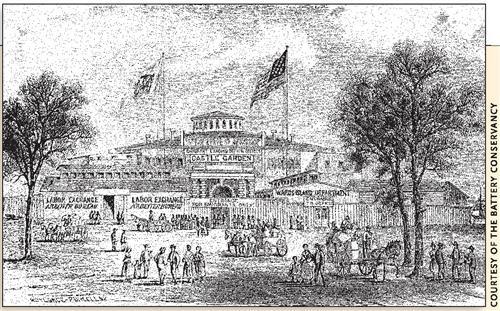
If you’re like me, you haven’t had much luck with the Ellis Island Web site <www.ellisisland.org>. Either you don’t have your ancestors’ names right (you’ve racked your brain for every possible spelling variation and still can’t find them), or they simply came through a different immigration station. Ellis Island didn’t open until 1892; if your forebears immigrated to New York Gty before then, they would’ve come through Castle Garden.
With the new CastleGarden.org Web site <castlegarden.org> (see the December 2005 Family Tree Magazine for a preview), you can search New York passenger lists from 1820 through 1913 for free. (Although Castle Garden was open only from 1830 to 1892, me Web site includes some immigrants who came before and after that time.) I took CasdeGarden.org and Stephen P. Morse’s companion search/ browse utilities at <www.stevemorse.org> for a spin to see how they stack up.
To run a Quick Search at CastleGarden.org, enter first and/or last names and select a range of arrival dates. The site doesn’t offer a Soundex search, but use an asterisk as a wildcard to find spelling variations. For example, Eisenst* dt brings up Eisenstadts, Eisenstaedts, Eisenstedts and Eisenstuedts. A search for W* Eisenstadt returns a William Eisenstadt and two Wolf Eisenstadts.
From the search-results page, you can refine your search by place of origin, occupation and ship. Each passenger’s record shows his name, age, sex, occupation, arrival date, origin, ship, port of departure, last residence and destination. The Comparative Data feature, under construction at press time, will give statistics such as the number of immigrants with your ancestor’s occupation.
CastleGarden.org also offers an Advanced Search, which lets you enter gender, age, ship, port of departure and other variables without specifying a name. The results-sent as an Excel spreadsheet-will cost you $45, a steep price considering you could get up to 25,000 matches per search. You’re probably better off buying a $79.95 subscription to Ancestry.com’s <Ancestry.com > US Immigration Collection, which allows you to search on more variables and see images of original ship manifests.
Unlike the Ellis Island site and Ancestry.com, CastleGarden.org doesn’t offer images of passenger lists. That’s a problem if you find someone whose name and age fit your ancestor’s profile, but you’re not certain it’s him. With an image of the original ship list, you can look for other relatives’ names. For instance, if your great-grandmother’s name appears below that of the person you suspect to be your great-grandfather, you likely have a match.
To help genealogists search Castle-Garden.org more efficiently, Morse has developed a One-Step search form at <www.stevemorse.org/ellis/cg.html>, which lets you search by name, year of arrival, occupation, origin and ship all at once. Morse also offers a Castle Garden Browser <www.stevemorse.org/ellis/cgbrowse.html>, which can help you find spelling variations and transcription errors of your ancestors’ names.
Every immigrant in the Castle Garden database gets a passenger-identification number (PLD), and according to Morse, these PIDs have been assigned in alphabetical order. In theory, if you know an immigrant’s PID, you can browse the database alphabetically for people with similar names. (See Morse’s FAQ page at <www.stevemorse.org/ellis/faqcg.htm> to learn how to get a passenger’s PID.)
Actually, it’s a little more complicated than that. On his FAQ page, Morse explains that “PIDs appear to cycle through the alphabet several times.” Morse has identified five PID cycles and “another eight ranges of PIDs within which the PIDs are somewhat random.”
Confused? Here’s how the browser works. Morse gives you access to each of the five alphabetical cycles plus the “miscellaneous PID ranges” he’s identified. Starting with the first range, click on the first letter of the name that interests you; this will take you to the first passenger record for that letter. Then use the numbered buttons (+1, −1, +10, −10) to browse the records for that letter. I tried this method to find people with the surname Eisenstadt. I finally came across the Eisenstadts in the third and fourth alphabetical cycles. Variations on the name were scattered throughout the cycles. (Mac users: If this feature doesn’t work, try clicking on a letter, and noting the PID. Add or subtract 1, 10, 100 or so on. Then hit the Refresh button in Safari, or in Internet Explorer, go back to the One-Step home page, click on Castle Garden Browser and type in the new PID. Hit Display PID and the new record should appear.)
CastleGarden.org certainly isn’t perfect yet. I’d like to see a Soundex search and images of passenger lists. But it’s a good start, especially for a free tool. And with Morse’s browser, you should be able to track down those mistranscribed relatives.
From the February 2006 issue of Family Tree Magazine.




